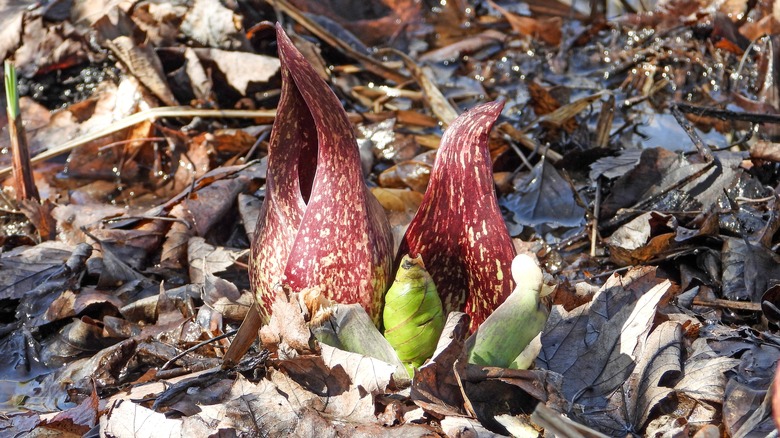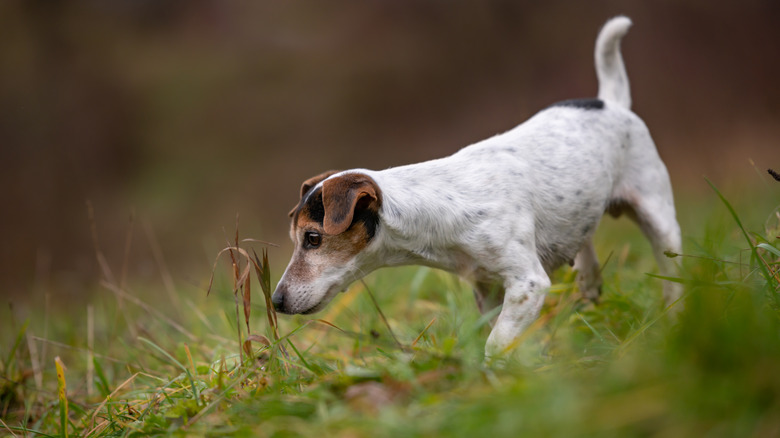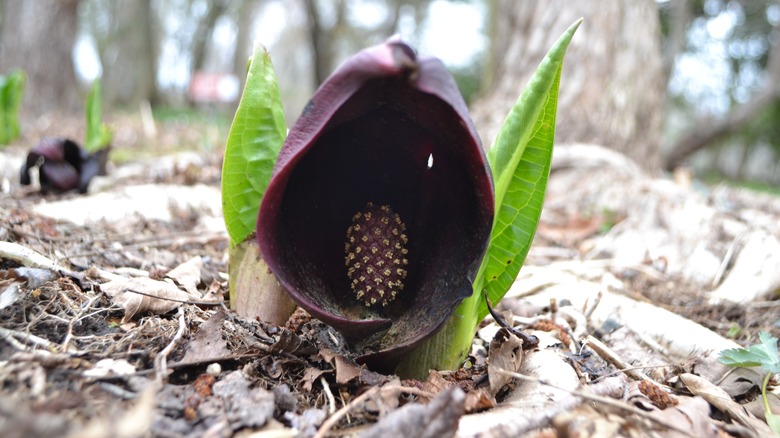The Reason You Should Kill Skunk Weed (& It's Not The Smell)
Skunk weed (Symplocarpus foetidus), also commonly known as skunk cabbage, is an intriguing member of the Araceae family found in and around swamps and wetlands. It has large leaves that are heart shaped and a most interesting flower that emerges in spring before the leaves form. The small green flowers grow on a spadix that is surrounded by a large purple-brown sheath and are positioned at ground level. But, don't get too close to these or be tempted to touch them because the offensive odor, which smells like decaying flesh, will have you moving away very quickly. However, that's not the primary reason you want to kill this weed if it happens to pop up in your garden.
This somewhat fascinating plant is also poisonous to both humans and animals. All parts of the plant are toxic including the flowers, leaves, fruits, seeds, stems, bark, roots and sap if ingested. While the pungent odor will likely keep humans from inadvertently ingesting any part of the plant, pets and other animals may be tempted to take a nibble which should be prevented. Although, you can keep your dog from munching on your garden with a common household staple.
What makes the skunk weed toxic?
Skunk weed contains calcium oxalate crystals that can cause burning and itching on the lips, tongue and in the throat. Generally, this unpleasant sensation should be enough to keep animals away after just a small nibble, but the plant also contains proteolytic enzymes that can cause swelling in the mouth and throat. This can inhibit swallowing and also impair breathing. Animals that have ingested plant parts will sometimes foam at the mouth and drool excessively. Vomiting and diarrhea may also be a result of ingesting this plant.
If poisoning has occurred, it's essential to provide supportive care and monitor your pet. But if there's no improvement or the swelling has caused difficulty in swallowing or breathing, you should consult a veterinarian straight away. All this should be reason enough to kill any skunk weed that might happen to pop up in your garden; however, if this plant intrigues you and you want to give it a spot somewhere in the garden, you'll need to find some useful tips for keeping your pets out of your garden.
How can you remove skunk weed from your garden?
While skunk cabbage is not commonly found as a garden plant and mainly grows in and around natural swamps and marshes, if you have a boggy spot in your garden, some seeds may have made their way into the area. This means that you might want to remove this plant from your garden if you have pets or young children. There are plenty of other flowering plants that thrive in soggy soil that you might like to grow instead.
Pulling out the skunk weed can be difficult because the plant forms a large root system with many fibrous roots that are essential for storing nutrients for the plant. You'll want to consider wearing a mask if you do this because of the offensive odor that will be released when the leaves are crushed. One way that you can remove this plant from your garden is by cutting the entire plant at the soil level and then painting the root tip with a herbicide. This will stop the plant from seeding or growing leaves. Eventually, the roots will run out of nutrients and die. Another method you can try is to cut the entire plant right down to the ground and then cover the root tip with either very thick cardboard or plastic sheeting. Heap some rocks or a thick layer of wood mulch on top. The plant shouldn't be able to grow through this and the roots will eventually die.


